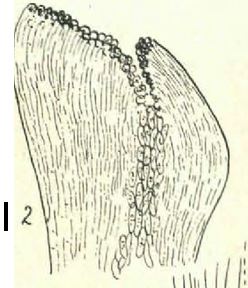Gratiola ramosa
(Gratiola means “petite gratifying” (flower), and ramosa means branchy.)
Plantaginaceae

Masthead on Dr. Garleanne’s Gratiola article.
Some species are a little mysterious. Gratiola is a lovely wetland wildflower you have to stop and bend over to enjoy. Like Rodney Dangerfield, it gets no respect, and no botanical attention. The literature on these plants is a black hole. Gratiola resembles a set of additional short-statured more or less related wetland species easily confused with each other: Axil-Flower (Mecardonia), (False-Pimpernels, species of Lindernia), and Bacopa species, sometimes also called “herbs of grace). They can be mildly confusing to sort out…not the time and place. With Covid dominating everything, it is tough to get out and botanize. Almost all natural areas are closed. Near my home is a small unnamed unofficial wetland I’ve been haunting socially distanced, befriending Gratiola.

Gratiola ramosa by John Bradford. Petals whote, and yellow with stripes in the tube.
The only meaty account of Gratiola I can find is fun to read, although in Dutch. I read Dutch fluently (thanks to Google Translator). Speaking of botany under duress, the account was written in the Netherlands in 1947, based on explorations in 1946. The Netherlands in 1946? Wow. And it makes me feel good that back then somebody, Dr. A. J. M. Garjeanne, went out and enjoyed Gratiola too. We had a parallel experience some 70 years and an ocean apart, and we noticed some of the same things.

The bud by JB.
- Dr. Garjeanne asserts: “Even in the still closed flower, the dust is already spreading out.”
The dust is the pollen…in short, the flowers release pollen before they open. That could indicate self-pollination, or merely that the flowers function as “male” before turning female. That Dr. Garjeanne had trouble finding immature and mature fruits put the kybosh on self-pollination, so he preferred the latter interpretation of male-first. In our area Gratiola makes fruits.
- In the words of Dr. G: “I can assure you that the stigmas on my specimens … are not irritable. In the few hundred flowers that I looked at, the stigmas were always on top of each other, and touch with a pencil, a needle and a pen did not change that. The stigmas do separate from each other by gentle lateral pressure (as is done by children with snapdragons).”
This requires some explanation and is interesting. In our local species the style and stigma (the pollen-receptive organ) looks like a garden hoe, the handle of the hoe being the style and the blade of the hoe being the stigma. Dr. Garjeanne perceived the hoe blade to be two flaps pressed tightly together, like two pages in a book. His illustration is below. I have tried to separate them under a microscope and fail. Also like Dr. G., I have poked and prodded them to find no irritability (motion in response to physical contact).

Dr. G’s picture of the large basal ovary, and the style and stigma toward the top. See the hoe?

Dr. Garjeanne’s 1947 picture of the stigma. He drew it with two flaps.

Hoe-shaped style and stigma yesterday. I cannot discern two flaps.
- To quote Dr. G: “We have already said that insect visits to Gratiola are so infrequent that I have not observed any visits, although in two cases I have found thrips in a flower (one in each flower).”
Me too. I have watched eagerly for the bees presumed to pollinate Gratiola and find it hard to catch pollinators in the act…but have caught on a GoPro footage of a small hymenopteran visiting two flowers and diving in fully fr a several seconds.
I’m sure they visit, but to agree with Dr G., not during my peeping, and guess what, I too find thrips in the blossoms. Thrips pollinate some flowers, but I kinda doubt they are important pollinators in Gratiola. Leave that to the bees lured by lots of nectar even if not when Dr. G or I watch. Thrips eat pollen, and I wonder if the complex structure of the Gratiola flowers protects pollen from thrips, as well as from other thieves.

Yep—thrips
If you look into the mouth of the flower you see a tangle of hairs you might say on the “roof,” with the flat face of that hoe-shaped stigma blocking the tunnel. The handle of the “hoe” extends back into the flower along the “roof,” and the blade partially blocks passage deep where the treasured nectar and pollen hide. The two anthers resides just interior to the hoe-blade style…the blade effectively shields the pollen, which seems also to hide behind the mass of hairs on the roof of the tube.

Lookin down the throat…there’s that big flat stigma blocking the tunnel.
There is a second purpose for the mass of hair according to other observers. Those sneaky private bees allegedly use the hairs as a foothold as they push deeply into the flower tube. Doing that would rub their bellies across the pollen-depositing anthers as well as against that weird hoe-blade pollen-receiving stigma.


Open flower. Stigma at the center with two anthers just behind (to the left).